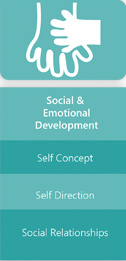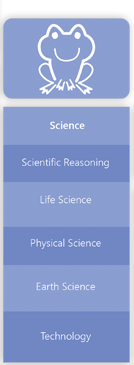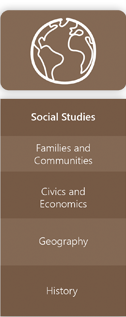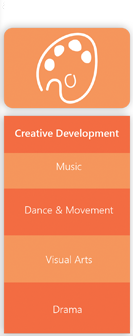what do children learn
The skills and learning goals are grouped into seven domains. Social-emotional, Physical, Language, and Math represent the core areas of child development. The other three domains Social studies, Science and Creative are applied sciences which focus on content learning that integrate the developmental curiosities and capabilities of the child.
Social & Emotional Development
Social and Emotional Development refers to a child’s ability to identify feelings, self-regulate and build relationships. Children who have strong social and emotional development are more likely to have good academic performance in future schooling.
Young children demonstrate Self Concept as they express preferences, take responsibility for their actions, and manage their feelings. Self direction is demonstrated by following rules and routines, maintaining attention and adapting. Social Relationship skills are demonstrated by connecting, cooperating, caring and responding to the needs of others.
Mathematics & Reasoning
Math and Reasoning skills include a child’s ability to count, understand number sense, manipulate objects in space, create patterns, sort, compare and measure.
Number concepts involve a child’s ability to identify, understand and manipulate numerals and quantities.
An understanding of shapes helps children develop spatial awareness and is strongly related to later geometric knowledge.
Spatial awareness is a child’s understanding of space, dimension and how objects are positioned in relation to self and others.
Patterning and Sorting are foundational math skills upon which many concepts such as multiplication and skip counting are based.
Measurement encompasses concepts of estimation and measuring.
Logic is a child’s ability to use reasoning and problem-solving skills to draw conclusions and find answers to question.
Science
Science skills include a child's ability to inquire, predict, and evaluate observations. They support a child's ability to explore everyday life, physical properties and to make sense of concepts such as weather, natural habitats and technology.
Scientific reasoning enables children to look at and evaluate the world critically and scientifically.
Knowledge of Life Science provides an understanding of the needs and characteristics of living organisms.
Physical Science investigations nurture a child's natural curiosity of finding out how things work and why things change.
Earth Science is the understanding of ecosystems and climates.
Technology is the use of tools to solve problems.
Physical Science
Physical Development refers to a child’s gross and fine motor skills. The child also requires adequate nutrition and fitness levels to support healthy growth and motor development.
Gross motor function is a child’s ability to manipulate and control large movements while Fine motor skills involve smaller muscles in the fingers, toes, eyes, wrists and ankles. Young children demonstrate health and safety by making healthy food choices, practicing good hygiene, and establishing safe practices.
Social Studies
Social Studies skills refer to a child's ability to understand oneself in relation to the surrounding world. It includes exploration of roles, responsibilities and cultural traditions.
By identifying, describing and comparing various roles within their families and communities , children gain understanding of their own role and responsibility within a community and also learn to respect cultures, traditions and diversity.
Civics and economics skills are a child's knowledge of how a community follows rules and trades to live together. Geography skills are a child's ability to identify, describe and navigate places.
Knowledge of history is a child's understanding of past events.
Language & Literacy
Language and Literacy skills refer to a child's ability to communicate and connect with others through listening, speaking, reading and writing.
Listening comprehension is a child's ability to hear, understand, and act on verbal language. Communication is a child's ability to use language especially oral or sign language, to convey ideas thoughts and feelings to other.
A child's vocabulary is the number of words a child knows and can use effectively.
Phonological awareness is a child's understanding of the sound structures of language and Concepts of Print is their understanding of elements and rule of written language, both helping them to learn how to read.
Letter and word recognition is the ability to identify the names of letters and their associated sounds.
Children demonstrate their Reading Comprehension by responding to text, retelling, and asking and answering questions.
Emergent writing is a child's ability to convey ideas, thoughts and feelings by using symbols, especially through drawing and writing.
Creative Development
Creative Development is the ability to respond to experiences by expressing ideas and the imagination through music, dance, dramatic play and art.
Music development is a child's exploration and understanding of sound, rhythm and tone.
Dance and Movement support the development of balance, coord ination and internal rhythm.
Visual arts invite children to use artistic tools, materials and media to create art and communicate ideas. Dramatic play allows a child play-out stories and social situations in a safe environment.









Social & Emotional Development
Social and Emotional Development refers to a child’s ability to identify feelings, self-regulate and build relationships. Children who have strong social and emotional development are more likely to have good academic performance in future schooling.
Young children demonstrate Self Concept as they express preferences, take responsibility for their actions, and manage their feelings. Self direction is demonstrated by following rules and routines, maintaining attention and adapting. Social Relationship skills are demonstrated by connecting, cooperating, caring and responding to the needs of others.